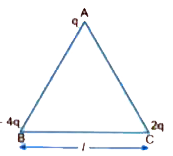Three like parallel forces P, Q and R are acting on the vertices of a ΔABC whose resultant passed through its centroid, then :
Pb=Qa=Rc
PtanA=QtanB=RtanC
P=Q=R
none of the above
The correct Answer is:C
Similar Questions
Three like parallel forces P, Q, R act at the corners of the triangle ABC. Their resultant passes through
centroid of the triangle if ………….
View SolutionThree like parallel forces P, Q, R act at the corners of the triangle ABC. Their resultant passes through
incentre of the triangle if ........
View Solution
Knowledge Check
The resultant of two like parallel forces P and Q passes through a point O if the resultant also passes through O when Q and R replace P and Q respectively then
AP,Q,R are in GPBQ,P,R are in GPCR,P,Q are in GPDP,Q,R are in APThe resultant of two like parallel forces P and Q passes through a point O if the resultant also passes through O when Q and R replace P and Q respectively then
AP,Q,R are in GPBQ,P,R are in GPCR,P,Q are in GPDP,Q,R are in APP and Q are like parallel forces. If P is moved parallel to itself through a distance x, then the resultant of Pand Q moves through a distance
APx/(P+Q)BPx/(P−Q)CPx/(P+2Q)DNone of these
Three like parallel forces P, Q, R act at the corners of the triangle ABC. Their resultant passes through
circumcentre of the triangle if ........
View SolutionThree like parallel forces P, Q, R act at the corners of the triangle ABC. Their resultant passes through
orthocentre of the triangle-if.........
View SolutionA line AB is divided into any two parts at C. The resultant of two like parallel forces P and Q acting through the middle point of AC and CB passes through C. If Pand Q be interchanged in position, their resultant will pass through the middle point of AB.
View SolutionThree point charges q,−4q and 2q are placed at the vertices of an equilateral triangle ABC of side 'l' as shown in the Fig. Obtain the experssion for the magnitude of the resultant electric force acting on the charge q.

View SolutionIf two like parallel forces of PQN and QPN have a resultant 2N, then :
View Solution
